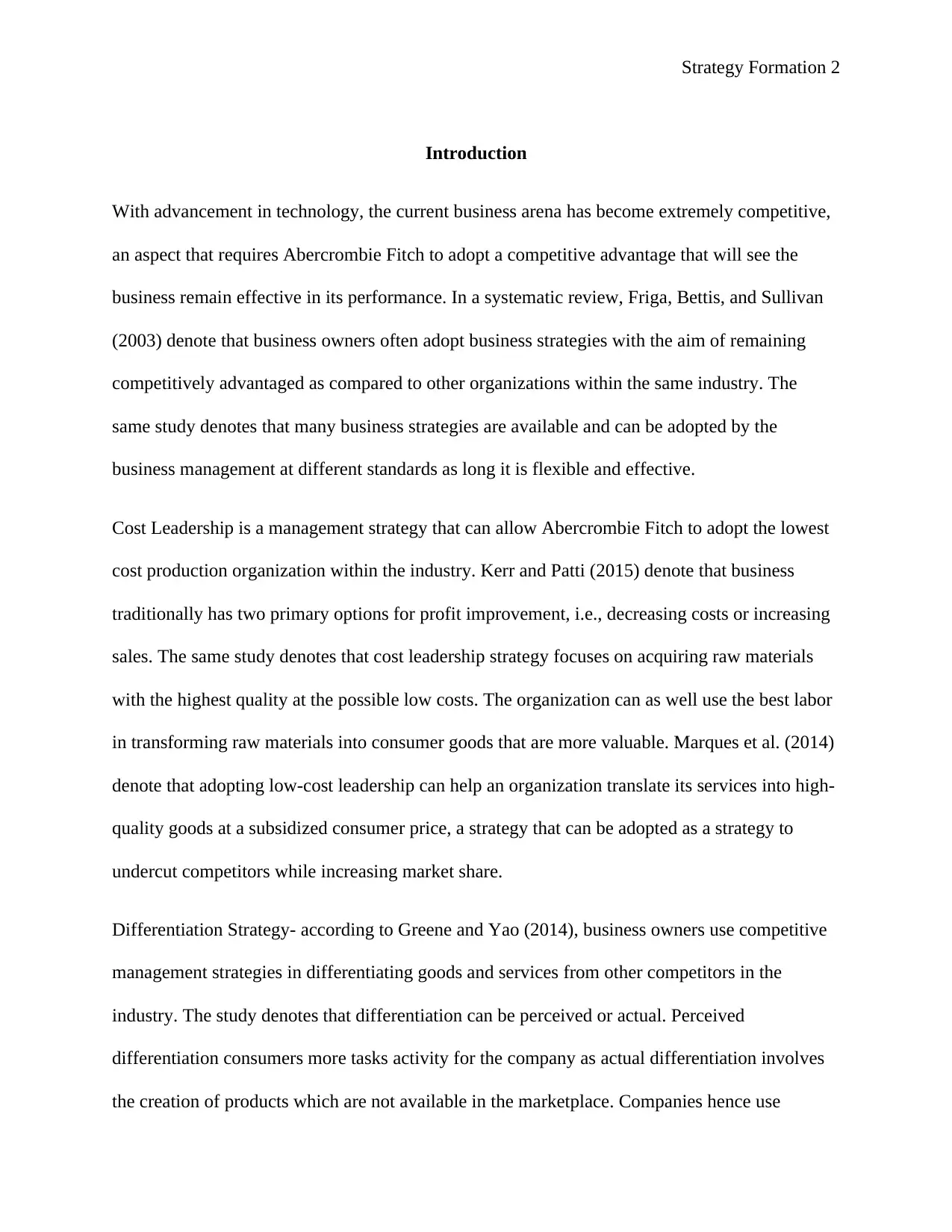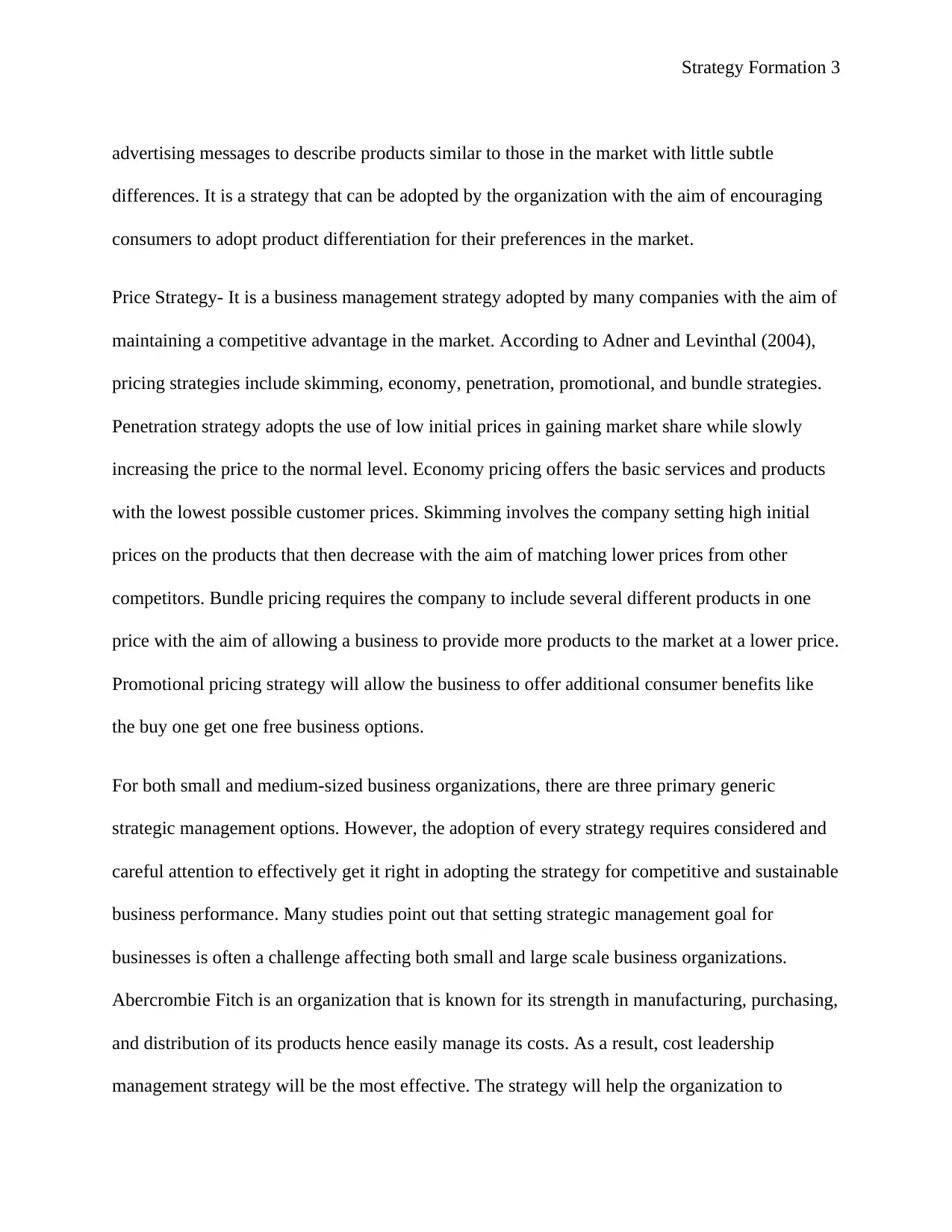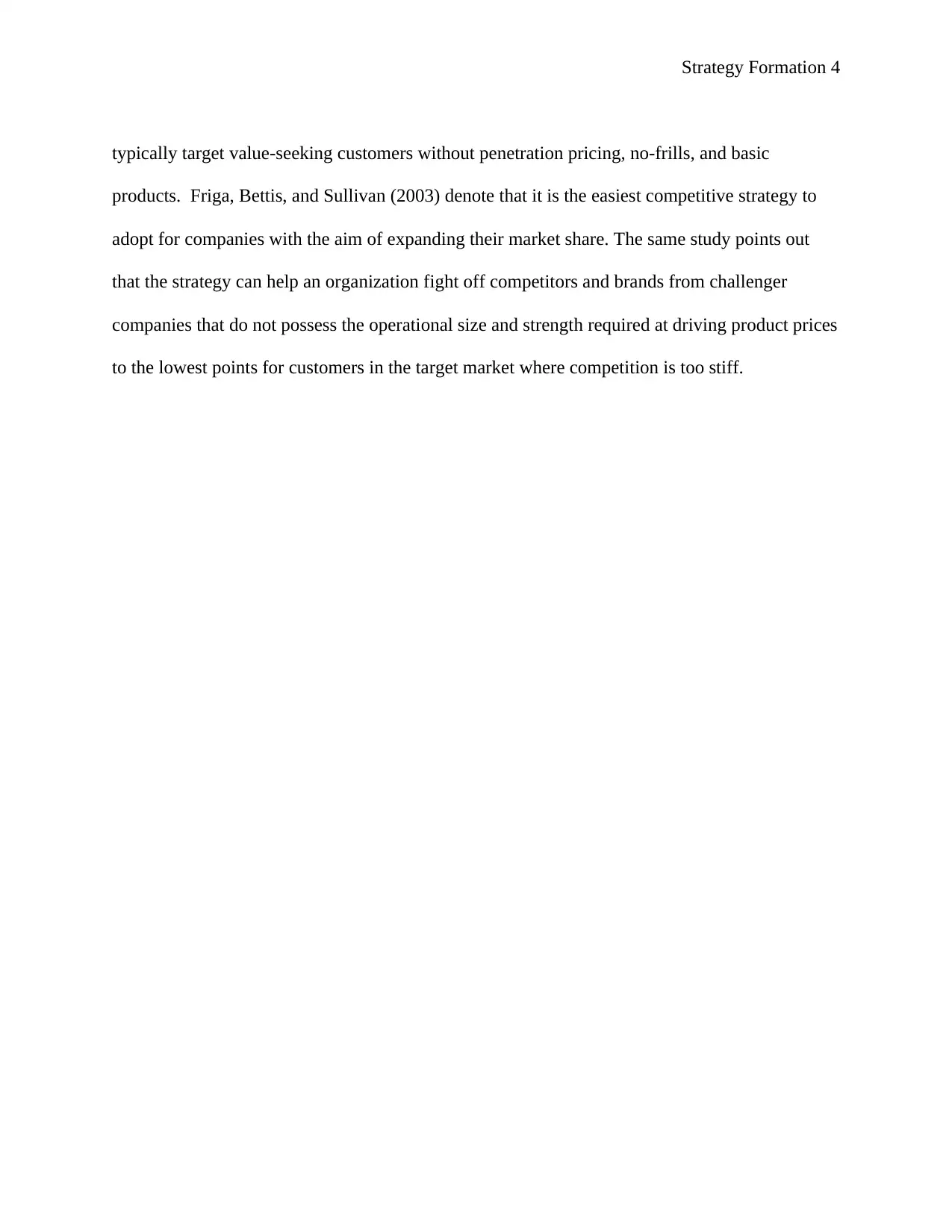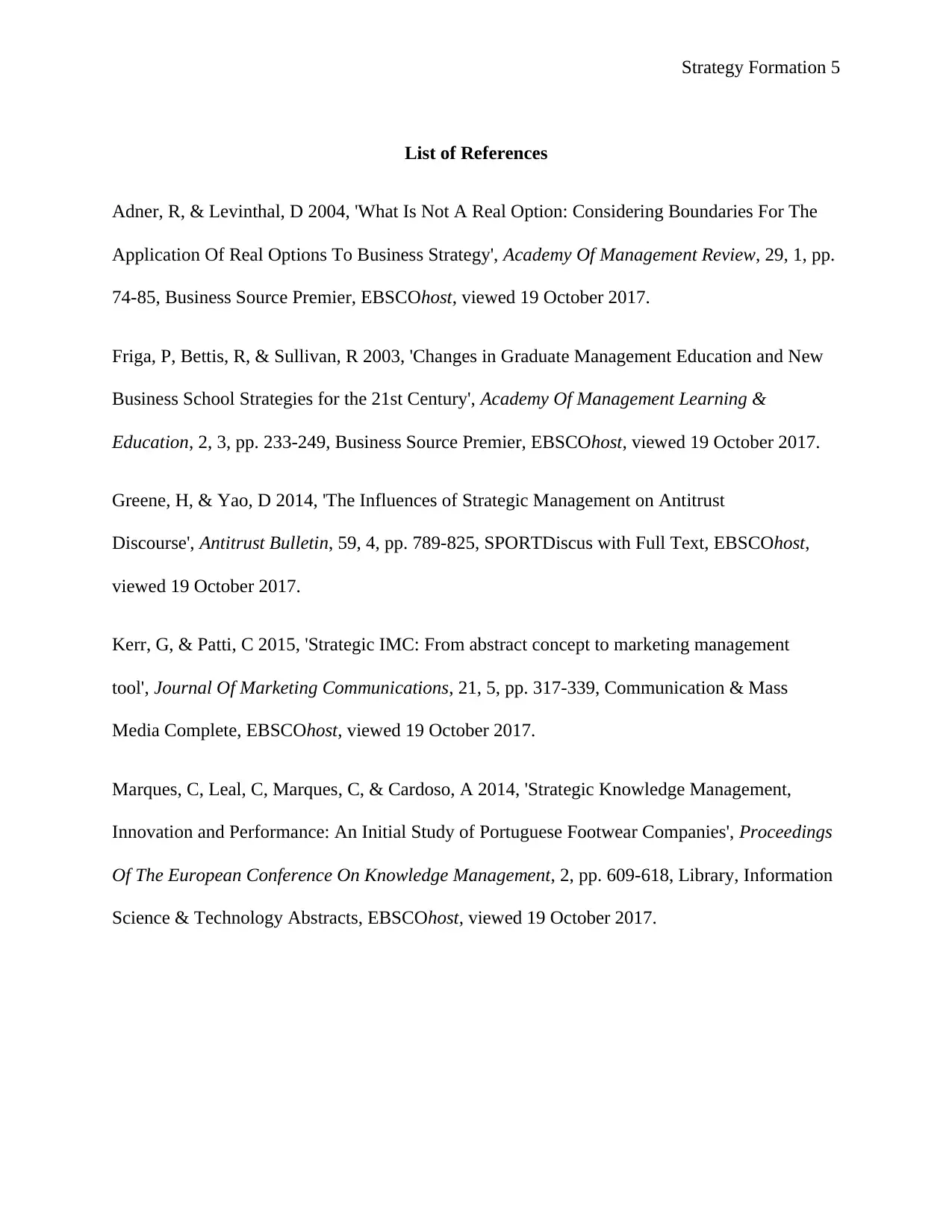Analysis of 5 Strategic Options for Business: Abercrombie & Fitch
VerifiedAdded on 2020/04/29
|5
|1012
|125
Report
AI Summary
This report examines five strategic options for businesses, particularly focusing on Abercrombie & Fitch. It begins by highlighting the competitive nature of the modern business environment and the necessity for companies to adopt strategies that provide a competitive advantage. The report then delves into three primary strategies: cost leadership, differentiation, and price strategy. Cost leadership is presented as a method to achieve low-cost production, allowing businesses to offer high-quality goods at subsidized prices and increase market share. Differentiation is discussed as a means of setting products apart from competitors through perceived or actual differences, while price strategies are explored through options like skimming, economy, penetration, promotional, and bundle strategies. The report concludes by suggesting that cost leadership is the most effective strategy for Abercrombie & Fitch, given its strengths in manufacturing and distribution, enabling it to target value-seeking customers effectively.

Strategy Formation 1
STRATEGIC OPTIONS IN BUSINESS
Name
Course
Tutor
University
City/State
Date
STRATEGIC OPTIONS IN BUSINESS
Name
Course
Tutor
University
City/State
Date
Paraphrase This Document
Need a fresh take? Get an instant paraphrase of this document with our AI Paraphraser

Strategy Formation 2
Introduction
With advancement in technology, the current business arena has become extremely competitive,
an aspect that requires Abercrombie Fitch to adopt a competitive advantage that will see the
business remain effective in its performance. In a systematic review, Friga, Bettis, and Sullivan
(2003) denote that business owners often adopt business strategies with the aim of remaining
competitively advantaged as compared to other organizations within the same industry. The
same study denotes that many business strategies are available and can be adopted by the
business management at different standards as long it is flexible and effective.
Cost Leadership is a management strategy that can allow Abercrombie Fitch to adopt the lowest
cost production organization within the industry. Kerr and Patti (2015) denote that business
traditionally has two primary options for profit improvement, i.e., decreasing costs or increasing
sales. The same study denotes that cost leadership strategy focuses on acquiring raw materials
with the highest quality at the possible low costs. The organization can as well use the best labor
in transforming raw materials into consumer goods that are more valuable. Marques et al. (2014)
denote that adopting low-cost leadership can help an organization translate its services into high-
quality goods at a subsidized consumer price, a strategy that can be adopted as a strategy to
undercut competitors while increasing market share.
Differentiation Strategy- according to Greene and Yao (2014), business owners use competitive
management strategies in differentiating goods and services from other competitors in the
industry. The study denotes that differentiation can be perceived or actual. Perceived
differentiation consumers more tasks activity for the company as actual differentiation involves
the creation of products which are not available in the marketplace. Companies hence use
Introduction
With advancement in technology, the current business arena has become extremely competitive,
an aspect that requires Abercrombie Fitch to adopt a competitive advantage that will see the
business remain effective in its performance. In a systematic review, Friga, Bettis, and Sullivan
(2003) denote that business owners often adopt business strategies with the aim of remaining
competitively advantaged as compared to other organizations within the same industry. The
same study denotes that many business strategies are available and can be adopted by the
business management at different standards as long it is flexible and effective.
Cost Leadership is a management strategy that can allow Abercrombie Fitch to adopt the lowest
cost production organization within the industry. Kerr and Patti (2015) denote that business
traditionally has two primary options for profit improvement, i.e., decreasing costs or increasing
sales. The same study denotes that cost leadership strategy focuses on acquiring raw materials
with the highest quality at the possible low costs. The organization can as well use the best labor
in transforming raw materials into consumer goods that are more valuable. Marques et al. (2014)
denote that adopting low-cost leadership can help an organization translate its services into high-
quality goods at a subsidized consumer price, a strategy that can be adopted as a strategy to
undercut competitors while increasing market share.
Differentiation Strategy- according to Greene and Yao (2014), business owners use competitive
management strategies in differentiating goods and services from other competitors in the
industry. The study denotes that differentiation can be perceived or actual. Perceived
differentiation consumers more tasks activity for the company as actual differentiation involves
the creation of products which are not available in the marketplace. Companies hence use

Strategy Formation 3
advertising messages to describe products similar to those in the market with little subtle
differences. It is a strategy that can be adopted by the organization with the aim of encouraging
consumers to adopt product differentiation for their preferences in the market.
Price Strategy- It is a business management strategy adopted by many companies with the aim of
maintaining a competitive advantage in the market. According to Adner and Levinthal (2004),
pricing strategies include skimming, economy, penetration, promotional, and bundle strategies.
Penetration strategy adopts the use of low initial prices in gaining market share while slowly
increasing the price to the normal level. Economy pricing offers the basic services and products
with the lowest possible customer prices. Skimming involves the company setting high initial
prices on the products that then decrease with the aim of matching lower prices from other
competitors. Bundle pricing requires the company to include several different products in one
price with the aim of allowing a business to provide more products to the market at a lower price.
Promotional pricing strategy will allow the business to offer additional consumer benefits like
the buy one get one free business options.
For both small and medium-sized business organizations, there are three primary generic
strategic management options. However, the adoption of every strategy requires considered and
careful attention to effectively get it right in adopting the strategy for competitive and sustainable
business performance. Many studies point out that setting strategic management goal for
businesses is often a challenge affecting both small and large scale business organizations.
Abercrombie Fitch is an organization that is known for its strength in manufacturing, purchasing,
and distribution of its products hence easily manage its costs. As a result, cost leadership
management strategy will be the most effective. The strategy will help the organization to
advertising messages to describe products similar to those in the market with little subtle
differences. It is a strategy that can be adopted by the organization with the aim of encouraging
consumers to adopt product differentiation for their preferences in the market.
Price Strategy- It is a business management strategy adopted by many companies with the aim of
maintaining a competitive advantage in the market. According to Adner and Levinthal (2004),
pricing strategies include skimming, economy, penetration, promotional, and bundle strategies.
Penetration strategy adopts the use of low initial prices in gaining market share while slowly
increasing the price to the normal level. Economy pricing offers the basic services and products
with the lowest possible customer prices. Skimming involves the company setting high initial
prices on the products that then decrease with the aim of matching lower prices from other
competitors. Bundle pricing requires the company to include several different products in one
price with the aim of allowing a business to provide more products to the market at a lower price.
Promotional pricing strategy will allow the business to offer additional consumer benefits like
the buy one get one free business options.
For both small and medium-sized business organizations, there are three primary generic
strategic management options. However, the adoption of every strategy requires considered and
careful attention to effectively get it right in adopting the strategy for competitive and sustainable
business performance. Many studies point out that setting strategic management goal for
businesses is often a challenge affecting both small and large scale business organizations.
Abercrombie Fitch is an organization that is known for its strength in manufacturing, purchasing,
and distribution of its products hence easily manage its costs. As a result, cost leadership
management strategy will be the most effective. The strategy will help the organization to
⊘ This is a preview!⊘
Do you want full access?
Subscribe today to unlock all pages.

Trusted by 1+ million students worldwide

Strategy Formation 4
typically target value-seeking customers without penetration pricing, no-frills, and basic
products. Friga, Bettis, and Sullivan (2003) denote that it is the easiest competitive strategy to
adopt for companies with the aim of expanding their market share. The same study points out
that the strategy can help an organization fight off competitors and brands from challenger
companies that do not possess the operational size and strength required at driving product prices
to the lowest points for customers in the target market where competition is too stiff.
typically target value-seeking customers without penetration pricing, no-frills, and basic
products. Friga, Bettis, and Sullivan (2003) denote that it is the easiest competitive strategy to
adopt for companies with the aim of expanding their market share. The same study points out
that the strategy can help an organization fight off competitors and brands from challenger
companies that do not possess the operational size and strength required at driving product prices
to the lowest points for customers in the target market where competition is too stiff.
Paraphrase This Document
Need a fresh take? Get an instant paraphrase of this document with our AI Paraphraser

Strategy Formation 5
List of References
Adner, R, & Levinthal, D 2004, 'What Is Not A Real Option: Considering Boundaries For The
Application Of Real Options To Business Strategy', Academy Of Management Review, 29, 1, pp.
74-85, Business Source Premier, EBSCOhost, viewed 19 October 2017.
Friga, P, Bettis, R, & Sullivan, R 2003, 'Changes in Graduate Management Education and New
Business School Strategies for the 21st Century', Academy Of Management Learning &
Education, 2, 3, pp. 233-249, Business Source Premier, EBSCOhost, viewed 19 October 2017.
Greene, H, & Yao, D 2014, 'The Influences of Strategic Management on Antitrust
Discourse', Antitrust Bulletin, 59, 4, pp. 789-825, SPORTDiscus with Full Text, EBSCOhost,
viewed 19 October 2017.
Kerr, G, & Patti, C 2015, 'Strategic IMC: From abstract concept to marketing management
tool', Journal Of Marketing Communications, 21, 5, pp. 317-339, Communication & Mass
Media Complete, EBSCOhost, viewed 19 October 2017.
Marques, C, Leal, C, Marques, C, & Cardoso, A 2014, 'Strategic Knowledge Management,
Innovation and Performance: An Initial Study of Portuguese Footwear Companies', Proceedings
Of The European Conference On Knowledge Management, 2, pp. 609-618, Library, Information
Science & Technology Abstracts, EBSCOhost, viewed 19 October 2017.
List of References
Adner, R, & Levinthal, D 2004, 'What Is Not A Real Option: Considering Boundaries For The
Application Of Real Options To Business Strategy', Academy Of Management Review, 29, 1, pp.
74-85, Business Source Premier, EBSCOhost, viewed 19 October 2017.
Friga, P, Bettis, R, & Sullivan, R 2003, 'Changes in Graduate Management Education and New
Business School Strategies for the 21st Century', Academy Of Management Learning &
Education, 2, 3, pp. 233-249, Business Source Premier, EBSCOhost, viewed 19 October 2017.
Greene, H, & Yao, D 2014, 'The Influences of Strategic Management on Antitrust
Discourse', Antitrust Bulletin, 59, 4, pp. 789-825, SPORTDiscus with Full Text, EBSCOhost,
viewed 19 October 2017.
Kerr, G, & Patti, C 2015, 'Strategic IMC: From abstract concept to marketing management
tool', Journal Of Marketing Communications, 21, 5, pp. 317-339, Communication & Mass
Media Complete, EBSCOhost, viewed 19 October 2017.
Marques, C, Leal, C, Marques, C, & Cardoso, A 2014, 'Strategic Knowledge Management,
Innovation and Performance: An Initial Study of Portuguese Footwear Companies', Proceedings
Of The European Conference On Knowledge Management, 2, pp. 609-618, Library, Information
Science & Technology Abstracts, EBSCOhost, viewed 19 October 2017.
1 out of 5
Related Documents
Your All-in-One AI-Powered Toolkit for Academic Success.
+13062052269
info@desklib.com
Available 24*7 on WhatsApp / Email
![[object Object]](/_next/static/media/star-bottom.7253800d.svg)
Unlock your academic potential
Copyright © 2020–2025 A2Z Services. All Rights Reserved. Developed and managed by ZUCOL.




